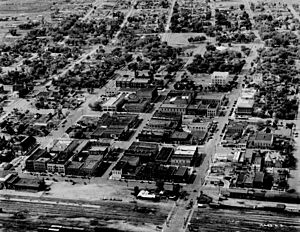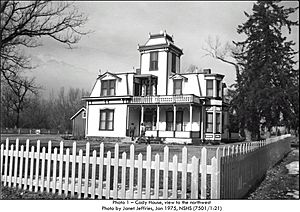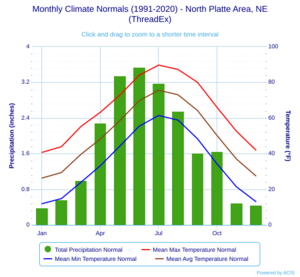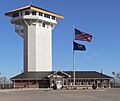North Platte, Nebraska facts for kids
Quick facts for kids
North Platte
|
|
|---|---|
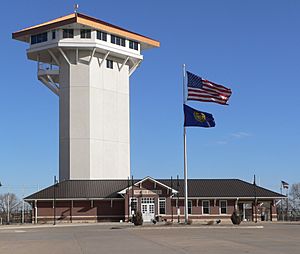
Golden Spike Tower and Visitor Center at
Union Pacific's Bailey Yards |
|
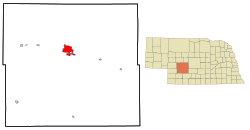
Location of North Platte within Lincoln County and Nebraska
|
|
| Country | United States |
| State | Nebraska |
| County | Lincoln |
| Area | |
| • Total | 13.71 sq mi (35.50 km2) |
| • Land | 13.52 sq mi (35.02 km2) |
| • Water | 0.19 sq mi (0.48 km2) |
| Elevation | 2,802 ft (854 m) |
| Population
(2020)
|
|
| • Total | 23,390 |
| • Density | 1,729.90/sq mi (667.93/km2) |
| Time zone | UTC−6 (Central (CST)) |
| • Summer (DST) | UTC−5 (CDT) |
| ZIP codes |
69101, 69103
|
| Area code(s) | 308 |
| FIPS code | 31-35000 |
| GNIS feature ID | 2395260 |
North Platte is a city in Nebraska, United States. It is the main city of Lincoln County. You can find it in the west-central part of the state. The city is located where the North and South Platte Rivers meet to form the Platte River.
In 2020, about 23,390 people lived in North Platte. This makes it the 11th largest city in Nebraska. North Platte is famous for its railroads. It is home to Union Pacific Railroad's huge Bailey Yard, which is the world's largest train yard.
During World War II, North Platte was known for the North Platte Canteen. This was a group of volunteers who gave food and a warm welcome to millions of soldiers traveling by train.
Contents
History of North Platte
North Platte started in 1866. This was when the Union Pacific Railroad built its tracks to this spot. The city gets its name from the North Platte River nearby.
For a short time, North Platte was the end of the Union Pacific Railway line. This was from December 1866 until the tracks were built further the next year. The railroad was a big part of connecting the eastern and western parts of the United States.
In the 1880s, the famous showman Buffalo Bill Cody built his ranch here. It was called Scout's Rest Ranch. Today, you can visit it as a National Historic Landmark.
The North Platte Canteen was a huge volunteer effort during World War II. Starting in 1941, thousands of people from North Platte and nearby towns helped. They met troop trains and offered coffee, sandwiches, and desserts. They served almost seven million soldiers passing through.
Geography and Climate
North Platte covers about 13.39 square miles (34.7 square kilometers). Most of this area is land, with a small part being water.
North Platte's Weather
North Platte has a dry continental climate. This means it has hot summers and cold winters. The average temperature in January is about 26.3°F (–3.2°C). In July, it's around 75.6°F (24.2°C).
Each year, North Platte usually has about 39 days where the temperature reaches 90°F (32°C) or higher. It also has about 12 days where the temperature drops to 0°F (–18°C) or lower. The highest temperature ever recorded was 112°F (44°C) in July 1954. The lowest was –35°F (–37°C) in January 1888 and February 1899.
Most of the rain falls in May and June. The city gets about 21 inches (535 mm) of precipitation each year. Snowfall averages about 29.6 inches (75 cm) per winter. Snow usually falls between November and April.
| Climate data for North Platte Regional Airport, Nebraska (1991–2020 normals, extremes 1874–present) | |||||||||||||
|---|---|---|---|---|---|---|---|---|---|---|---|---|---|
| Month | Jan | Feb | Mar | Apr | May | Jun | Jul | Aug | Sep | Oct | Nov | Dec | Year |
| Record high °F (°C) | 74 (23) |
79 (26) |
91 (33) |
98 (37) |
99 (37) |
108 (42) |
112 (44) |
108 (42) |
105 (41) |
96 (36) |
87 (31) |
76 (24) |
112 (44) |
| Mean maximum °F (°C) | 62.6 (17.0) |
66.7 (19.3) |
77.9 (25.5) |
84.8 (29.3) |
90.0 (32.2) |
96.9 (36.1) |
100.6 (38.1) |
97.9 (36.6) |
95.3 (35.2) |
86.3 (30.2) |
73.9 (23.3) |
63.7 (17.6) |
102.0 (38.9) |
| Mean daily maximum °F (°C) | 40.7 (4.8) |
43.9 (6.6) |
55.2 (12.9) |
63.2 (17.3) |
72.8 (22.7) |
84.0 (28.9) |
89.7 (32.1) |
87.2 (30.7) |
80.0 (26.7) |
66.0 (18.9) |
52.6 (11.4) |
42.0 (5.6) |
64.8 (18.2) |
| Daily mean °F (°C) | 26.3 (−3.2) |
29.4 (−1.4) |
39.6 (4.2) |
48.2 (9.0) |
58.5 (14.7) |
69.7 (20.9) |
75.6 (24.2) |
73.0 (22.8) |
64.2 (17.9) |
50.2 (10.1) |
37.0 (2.8) |
27.5 (−2.5) |
49.9 (9.9) |
| Mean daily minimum °F (°C) | 11.9 (−11.2) |
14.8 (−9.6) |
23.9 (−4.5) |
33.2 (0.7) |
44.2 (6.8) |
55.4 (13.0) |
61.4 (16.3) |
58.8 (14.9) |
48.3 (9.1) |
34.3 (1.3) |
21.4 (−5.9) |
13.1 (−10.5) |
35.1 (1.7) |
| Mean minimum °F (°C) | −8.2 (−22.3) |
−5.1 (−20.6) |
4.6 (−15.2) |
17.1 (−8.3) |
27.5 (−2.5) |
41.4 (5.2) |
49.5 (9.7) |
46.9 (8.3) |
31.7 (−0.2) |
17.0 (−8.3) |
4.3 (−15.4) |
−5.1 (−20.6) |
−14.5 (−25.8) |
| Record low °F (°C) | −35 (−37) |
−35 (−37) |
−25 (−32) |
−3 (−19) |
18 (−8) |
29 (−2) |
39 (4) |
35 (2) |
17 (−8) |
4 (−16) |
−25 (−32) |
−34 (−37) |
−35 (−37) |
| Average precipitation inches (mm) | 0.39 (9.9) |
0.57 (14) |
1.00 (25) |
2.29 (58) |
3.35 (85) |
3.54 (90) |
3.18 (81) |
2.56 (65) |
1.61 (41) |
1.65 (42) |
0.49 (12) |
0.45 (11) |
21.08 (535) |
| Average snowfall inches (cm) | 5.1 (13) |
6.9 (18) |
4.2 (11) |
3.6 (9.1) |
0.0 (0.0) |
0.0 (0.0) |
0.0 (0.0) |
0.0 (0.0) |
0.1 (0.25) |
2.2 (5.6) |
3.0 (7.6) |
4.5 (11) |
29.6 (75) |
| Average extreme snow depth inches (cm) | 3.5 (8.9) |
4.3 (11) |
2.7 (6.9) |
1.8 (4.6) |
0.0 (0.0) |
0.0 (0.0) |
0.0 (0.0) |
0.0 (0.0) |
0.0 (0.0) |
0.9 (2.3) |
2.0 (5.1) |
2.8 (7.1) |
6.8 (17) |
| Average precipitation days (≥ 0.01 in) | 4.4 | 5.3 | 6.5 | 9.0 | 11.5 | 10.8 | 10.2 | 8.9 | 6.7 | 6.8 | 4.2 | 3.7 | 88.0 |
| Average snowy days (≥ 0.1 in) | 4.3 | 4.3 | 3.4 | 2.2 | 0.1 | 0.0 | 0.0 | 0.0 | 0.1 | 0.9 | 2.1 | 3.6 | 21.0 |
| Average relative humidity (%) | 69.3 | 68.2 | 64.4 | 59.6 | 63.3 | 63.9 | 63.0 | 64.1 | 63.8 | 61.5 | 66.9 | 69.6 | 64.8 |
| Average dew point °F (°C) | 11.7 (−11.3) |
16.3 (−8.7) |
23.2 (−4.9) |
32.2 (0.1) |
43.9 (6.6) |
53.8 (12.1) |
58.8 (14.9) |
56.8 (13.8) |
46.8 (8.2) |
34.2 (1.2) |
23.0 (−5.0) |
14.0 (−10.0) |
34.5 (1.4) |
| Mean monthly sunshine hours | 185.0 | 180.2 | 227.4 | 257.5 | 290.8 | 322.9 | 352.9 | 319.2 | 259.5 | 236.2 | 174.0 | 170.0 | 2,975.6 |
| Percent possible sunshine | 62 | 60 | 61 | 64 | 65 | 71 | 77 | 75 | 69 | 69 | 59 | 59 | 67 |
| Source: NOAA (relative humidity and sun 1961–1990) | |||||||||||||
Population of North Platte
| Historical population | |||
|---|---|---|---|
| Census | Pop. | %± | |
| 1880 | 363 | — | |
| 1890 | 3,055 | 741.6% | |
| 1900 | 3,640 | 19.1% | |
| 1910 | 4,793 | 31.7% | |
| 1920 | 10,466 | 118.4% | |
| 1930 | 12,061 | 15.2% | |
| 1940 | 12,429 | 3.1% | |
| 1950 | 15,433 | 24.2% | |
| 1960 | 17,184 | 11.3% | |
| 1970 | 19,447 | 13.2% | |
| 1980 | 24,509 | 26.0% | |
| 1990 | 22,605 | −7.8% | |
| 2000 | 23,878 | 5.6% | |
| 2010 | 24,733 | 3.6% | |
| 2020 | 23,390 | −5.4% | |
| U.S. Decennial Census | |||
2020 Census Data
In 2020, the 2020 United States census counted 23,390 people living in North Platte. There were 10,188 households. Most residents, about 86.5%, were white. About 10% of the population identified as Hispanic or Latino.
About 24.6% of the people were under 18 years old. The average age in the city was 38.9 years.
2010 Census Data
In 2010, there were 24,733 people living in North Platte. The population density was about 1,874 people per square mile. About 93.1% of the people were White. About 8.8% of the population was Hispanic or Latino.
About 30.4% of households had children under 18. The average household had 2.29 people. The average family had 2.95 people. The median age in the city was 37.1 years.
Arts and Culture
North Platte has many interesting places to visit.
- The Lincoln County Historical Museum shows the history of the North Platte Canteen. It also has a Prairie Village. This village includes old homes and buildings, like a Pony Express station.
- Buffalo Bill Ranch State Historical Park is near North Platte. It's a living history park about "Buffalo Bill" Cody. You can see his actual house, called Scout's Rest Ranch.
Every June, North Platte hosts "Nebraskaland Days." This event includes parades, art shows, rodeos, and concerts. Over 100,000 people attend it each year.
North Platte also hosts the annual Miss Nebraska pageant. This is a competition that leads to the Miss America Organization.
The city has had professional baseball teams. The North Platte 80s started playing in 2024.
City Infrastructure
Transportation
North Platte is home to Bailey Yard, the world's largest train yard. You can visit the Golden Spike Tower and Visitor Center. This eight-story building gives you a great view of the huge train yard.
North Platte also has the North Platte Regional Airport. You can fly from here to Denver International Airport. There is also a bus system for people living in the town.
Long-distance bus services like Burlington Trailways and Express Arrow also serve the city.
Major highways run through North Platte. Interstate 80 passes south of the city. U.S. Route 83 goes through downtown. U.S. Route 30 also crosses the city.
Media
Notable People
Many interesting people have connections to North Platte:
- Chris Başak: A baseball player who played for the New York Yankees.
- Howard Baskerville: An American teacher known as the "American Martyr of the Constitutional Revolution" in Iran.
- Buffalo Bill Cody: The famous Wild West showman who owned a ranch here.
- Nathan Enderle: A football quarterback drafted by the Chicago Bears.
- Chuck Hagel: A former U.S. Senator and U.S. Secretary of Defense.
- Bill Hayes: A baseball player who lived in North Platte.
- Evelyn Hooker: A psychologist known for her research on homosexuality.
- John Howell: A former American football safety in the NFL.
- Glenn Miller: A popular big band leader who lived here as a child.
- Keith Neville: The 18th governor of Nebraska.
- Red Cloud: A famous Sioux warrior, born near North Platte.
- Ryan Schultz: A professional mixed martial artist.
- Zane Smith: A professional baseball player who played in the major leagues.
- Danny Woodhead: A retired NFL running back.
Images for kids
See also
 In Spanish: North Platte (Nebraska) para niños
In Spanish: North Platte (Nebraska) para niños


